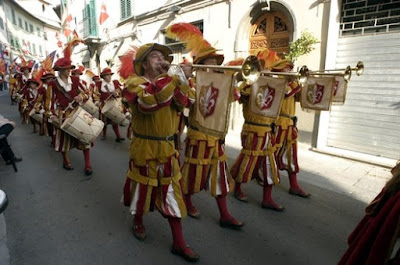Ceretto Guidi is a charming hilltop village situated only 30 minutes from Florence and can be explored in a few hours. The town has a long history with the first mention dating back to the 8th century. It went through many feudal wars and upheavals.
 |
| Cerreto Guidi |
In the heart of the town stands the majestic Villa Medicea built in 1555 by Cosimo I dei Medici, who used it as a hunting residence. A local legend tells that Isabella dei Medici, Cosimo’s daughter, was strangled here by her husband, Paolo Giordano I Orsini, duke of Bracciano, for infidelity. Since then, it is believed that the ghost of Isabella wanders around the villa, which has been turned into a museum with an eclectic collection of artefacts and furniture from various historic periods. Curious visitors are shown the bedroom where the noble woman was supposedly killed. Check out the Historical Museum of Hunting on the first floor of the building to see hunting weapons from the 17th to 19th centuries.
There are several beautiful churches in the area that are worth exploring such as the Pieve di San Leonardo, Santuario di Santa Liberata and Oratorio di San Jacopo. Strolling along the ancient streets of Cerreto Guidi is like stepping back in time: old palaces, artisan workshops and stunning views over the surrounding vineyards and olive groves here have not changed much for centuries.
 |
| Palio del Cerro |
Every year in September, the town hosts the Renaissance-style Palio del Cerro, a historic event dedicated to the patron saint Santa Liberata with games, races and a costumed parade in which the town's residents of all ages participate. In July, visitors enjoy the bounty of hearty traditional dishes at the food festival Sagra del Papero e del Cinghiale and wine fair Mostra Mercato del Vino Chianti.
Photos by: Patrice Wangen/Flickr, Proloco Cerreto Guidi.

















